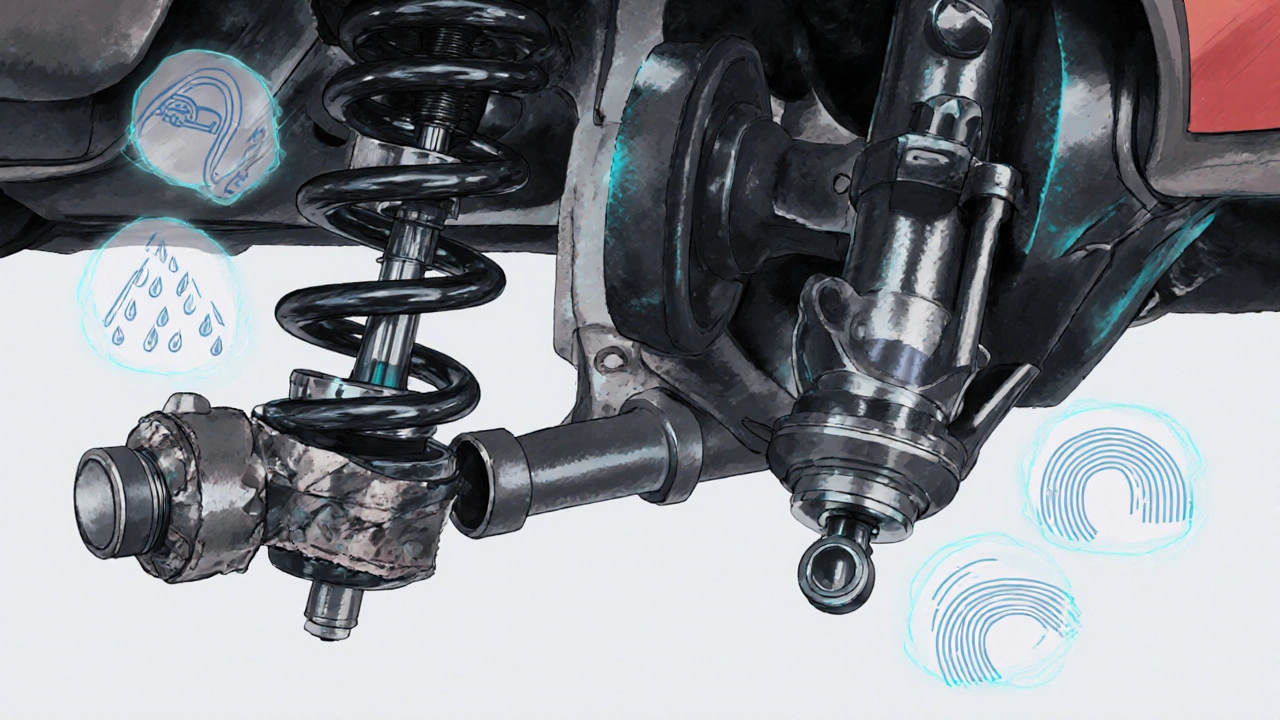Suspension Upgrade Selector
Select your driving priorities to get personalized suspension recommendations.
Your Budget
Primary Driving Use
Climate Considerations
Height Preference
Lowering springs are popular. They’re cheap, easy to install, and make your car look aggressive. But if you’ve ever driven one, you know the trade-off: a harsh ride, poor cornering, and tires that scrape curbs on every driveway. You didn’t buy a sports car just to bounce over speed bumps. So what’s the real alternative to lowering springs? The answer isn’t just one part-it’s a smarter system.
Coilovers Are the Direct Upgrade
Coilovers replace your stock springs and shocks with a single unit that lets you adjust ride height and damping. Unlike lowering springs, which only make the car sit lower, coilovers give you control over how stiff or soft the suspension feels. You can fine-tune it for daily driving, weekend track days, or even snow-covered roads.
Most quality coilovers-like those from KW, TEIN, or BC Racing-let you adjust ride height by turning a collar at the bottom of the strut. That means you can raise the car slightly for speed bumps or parking garages, then drop it back down for a sharp turn. You’re not stuck with one fixed setting.
And here’s the kicker: coilovers often include adjustable damping. Turn the knob on the shock body, and you change how fast the suspension rebounds. A firmer setting reduces body roll in corners. A softer setting smooths out rough pavement. Lowering springs can’t do any of that.
Why Lowering Springs Fall Short
Lowering springs are just shorter versions of your factory springs. They don’t change the shock absorbers. That’s a problem because shocks are designed to work with a specific spring rate and travel length. When you cut the springs, you’re forcing the shocks to operate outside their ideal range.
Result? The shocks wear out faster. You get more bounce after hitting a bump. The car feels jumpy and unpredictable. In Melbourne’s old concrete roads, that’s not just uncomfortable-it’s unsafe. You lose grip when the tire loses contact with the road.
Plus, lowering springs often make your alignment worse. Your camber and toe angles shift, leading to uneven tire wear. You might need a new alignment after installation, and even then, you’re still stuck with a ride that’s too stiff.
What About Air Suspension?
If you want maximum flexibility, air suspension is the next step up. It uses air bags instead of metal springs. You control the ride height with a button or smartphone app. Need to clear a speed hump? Raise it 2 inches. Going on the highway? Lower it for better aerodynamics. Driving in rain? Keep it higher to avoid water pooling.
Popular systems like Air Lift Performance or AccuAir let you save multiple presets. One for cruising, one for shows, one for track days. It’s not cheap-expect to pay $2,000 to $4,000 installed-but if you drive in mixed conditions, it’s the most versatile option.
Downsides? Air systems need maintenance. Compressors can fail. Air lines can leak. They’re not ideal for daily drivers in freezing climates unless you add insulation. But if you live in a city with rough roads and want to look good while staying comfortable, air suspension is the ultimate alternative.

Performance Struts and Sport Springs
Not everyone wants to spend thousands. If you still want to lower your car but avoid the worst of lowering springs, consider performance struts paired with slightly lowered sport springs.
Brands like Koni, Bilstein, and Eibach make sport springs that are only 10-20% shorter than stock. They’re designed to work with upgraded shocks. You get a subtle drop-about 1 to 1.5 inches-and a noticeable improvement in handling without the brutal ride.
Pair those with adjustable performance struts (like Koni Yellow or Bilstein B8), and you’ve got a balanced setup. The struts control the motion better, the springs provide support, and you avoid the harshness of cheap lowering springs.
This combo costs about $800-$1,200 installed. It’s not as adjustable as coilovers, but it’s a huge step up from stock or budget springs.
What About Camber Kits and Alignment?
No matter what suspension upgrade you choose, you’ll need an alignment afterward. Lowering changes the angle of your wheels. Without proper camber and toe settings, your tires will wear out fast-and your handling will suffer.
A camber kit adds adjustable control arms that let you correct the angle. Most lowering springs force negative camber, which makes the tires lean inward. That’s good for cornering, but bad for straight-line wear. A camber kit lets you dial it in just right.
For coilovers or air suspension, camber kits are often built in. For sport springs, you’ll need to add them separately. Don’t skip this step. It’s not optional.
Real-World Example: A 2020 Honda Civic Type R
A friend of mine had a 2020 Civic Type R with lowering springs. He loved the look but hated how it felt. Every pothole felt like a punch. Tire wear was uneven. He couldn’t drive it in the rain without worrying about hydroplaning.
He switched to KW Variant 3 coilovers. The ride improved instantly. He could soften it for the freeway, firm it up for the track. He saved a preset for his daily commute. After a proper alignment with a camber kit, his tires lasted 20,000 miles instead of 8,000.
He didn’t just fix his car-he made it better than stock.

Which Option Fits Your Needs?
Here’s how to choose:
- On a tight budget? Go with sport springs + performance struts. You get 80% of the benefit for half the cost.
- Want full control? Coilovers are the sweet spot. Adjustable height and damping. Reliable. Proven on tracks and streets.
- Drive in all weather? Need to clear driveways or speed humps? Air suspension gives you the most flexibility. Just budget for maintenance.
- Just want to look lower? Avoid lowering springs. They’re the worst compromise. Go with a subtle drop and proper alignment instead.
There’s no single ‘best’ option. But there is a best option for you. Ask yourself: Do you drive for comfort? For performance? For looks? Your answer will point you in the right direction.
What to Avoid
Stay away from cheap, no-name lowering springs from eBay or Amazon. They’re often made from low-grade steel. They sag over time. They’re not engineered for your car’s weight or suspension geometry. You’re not saving money-you’re buying a safety risk.
Also avoid ‘cutting’ your springs. Some people try to shorten them with a grinder. That weakens the metal. It’s dangerous. Don’t do it.
And never install any suspension upgrade without a proper alignment. Even the best parts fail if the wheels aren’t set right.
Final Thought: It’s Not About How Low You Go
It’s about how well you drive. A car that sits 2 inches lower but handles smoothly, grips the road, and doesn’t destroy your tires is better than one that’s slammed but bounces like a pogo stick.
The alternative to lowering springs isn’t just another part. It’s a smarter approach to suspension. You don’t have to choose between looks and comfort. You can have both-once you stop thinking in terms of springs and start thinking in terms of systems.
Are coilovers worth the extra cost over lowering springs?
Yes, if you drive regularly. Lowering springs cost $200-$400 but ruin your ride quality and wear out faster. Coilovers cost $800-$2,000 but last longer, let you adjust height and stiffness, and improve handling. Over time, you save money on tires, shocks, and alignment repairs.
Can I install coilovers myself?
You can, if you have experience with suspension work and the right tools-spring compressors, torque wrenches, jack stands. But it’s risky. Improper installation can damage struts or cause alignment issues. Most people pay $300-$600 for professional installation. It’s worth it for safety and precision.
Do air suspensions work in cold weather?
They can, but moisture in the air lines can freeze, causing leaks or compressor failure. Many systems include air dryers and insulated lines for colder climates. If you live in Melbourne winters, go for a system with anti-freeze features or keep your car in a garage.
Will any suspension upgrade affect my car’s warranty?
Yes. Most manufacturers void the warranty on suspension-related components if you modify them. However, if the modification doesn’t cause a failure, the dealer can’t deny coverage on unrelated parts. Some brands offer OEM-approved aftermarket parts-check your manual or ask your dealer.
How long do coilovers last?
Quality coilovers last 80,000 to 120,000 miles with normal use. Cheaper ones may wear out in 40,000. Signs of failure include leaking oil, clunking noises, or uneven ride height. Regular inspections every 20,000 miles help catch issues early.




